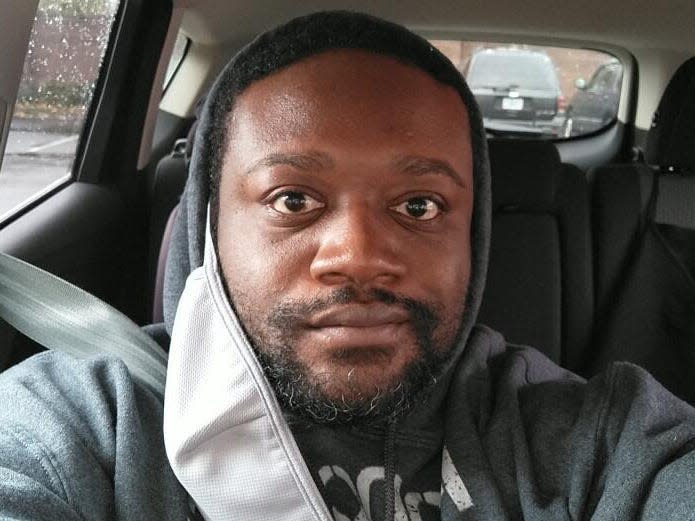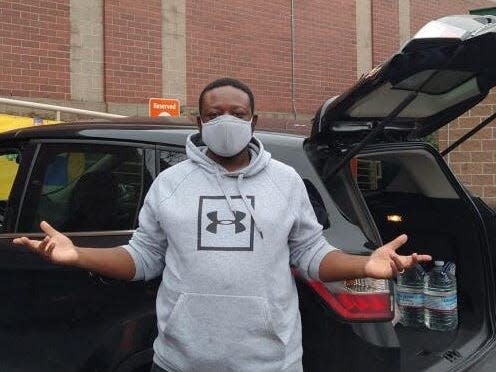I'm a DoorDash delivery driver who makes anywhere from $200 to $800 a week. Here's what I wish I knew before signing up to drive for the company.

Mike Hayes, 35, is a DoorDash delivery driver in Oregon.
He can make up to $800 working about 45 hours a week; on slower weeks he earns more like $200 to $300.
This is his story, as told to freelance writer Meira Gebel.
In March 2020, I was laid off from my full-time job as a chef due to the coronavirus pandemic. While I was job searching on Craigslist, I kept coming across ads to be a delivery driver for DoorDash, so I thought "Why not?" and decided to apply.
I wanted to do something other than cooking, I was a chef for over 17 years, and was feeling burned out by it. I decided to watch YouTube videos and find Reddit groups talking about what it was like to be a Dasher: how it worked, and how successful you could be. I saw promising things, so I was excited for my first day.
I was hired as a Dasher in September 2020. The application process is fairly standard. You have to show that you have a driver's license and proof of insurance and have to pass a background check - which came back quickly. After that all came back clear, I was ready to start working the very next day. During my first shift, I made $50 in two hours and was sold, and started working regularly three to four days a week.
I work roughly eight hours a day, six days a week.

On the days I work as a Dasher, I wake up around 7 a.m. to take my wife to work. Then, I come home and wake my older daughter up and get her breakfast ready so that she is ready for school. I check the app to see if it's busy. If it is, I may log on just for an hour or two for the breakfast rush. If not, I drop my younger daughter off at my sister-in-law's house, and get on the road around 9 a.m.
I live in Forest Grove, Oregon, about a 35-minute drive west of downtown Portland. I try to stay around Beaverton and Hillsboro when I'm doing orders, because I don't like to be too far away from home. If it's a slow morning, sometimes I'll make the trip to Portland because it's always busy there.
If there are no orders in your immediate location, the DoorDash app will instruct you to drive to a "hot spot" - an area that has a lot of restaurants that tend to be busy. Once you arrive at a hotspot, an order will pop up on your screen and you have a few seconds to accept or decline. Sometimes you'll have to wait a long time - the longest I've waited for an order has been about 45 minutes.
After you've accepted an order, you will drive to the restaurant to pick it up.
Most of the time, the restaurant already has the order ready to go and placed aside, but there are times where you have to sit around and wait.
Waiting for an order to be ready is sometimes inconvenient but understandable. Still, there's been multiple times where I've been waiting for an order just to see a line of customers come and go while I'm still waiting. Some restaurants don't prioritize delivery app orders, and instead seem to put in-store customers first.
Once the order is ready, you drive it to the customer's location, which can be anywhere from a half mile away to 30 miles. Before you accept an order, you can see how far the delivery is going to be and how much the payout is. On DoorDash, the customer tips before they place the order. The standard default is usually 20% but customers have 24 hours to change the tip amount after they've received their order.
Sometimes you will get a "stacked" order, meaning two orders from the same restaurant going in the same direction, or two orders from two separate restaurants going in the same direction.
I go back home at 2:30 p.m. to take a break before heading back out for the dinner rush at 4:30 p.m. After the dinner rush, I'm home by 8 p.m. With COVID-19, most of our orders require us to leave the food at the front door, but there is the rare occasion where a customer will request it to be handed to them in person.
Since we can see what the payout will be before we accept an order, offers with the lowest tip generally get passed down through different Dashers before someone accepts it.
My biggest piece of advice for customers is to tip more than $5 on your delivery if you want it to arrive fast. The bigger the tip, the more incentive the Dasher will accept it right away and to get it to you quickly. And the more you tip, the more we get paid. Tips are our livelihood, since we don't depend on the DoorDash base pay.
The base pay for DoorDash is something like $3 an hour, so we are really dependent on tips. If someone only tips $3, that's only about $7 for the entire delivery, which sometimes isn't even worth the gas. I've gotten offers for $3.75 to drive 30 miles, and that's just ridiculous.
On a good week, I can make up to $800 working about 45 hours a week. On a bad week, which has been normal lately unfortunately, I can make around $200 to $300.
The incentives and bonuses DoorDash offers its Dashers are not realistic.

Most of the bonuses and incentives we get are not worth it. If there is a $2 bonus pay, that will only make up for what people aren't tipping. DoorDash will routinely offer $2 bonus pay or other cash incentives to get more drivers out and working. Sometimes they'll offer a $50 bonus if you complete a certain number of orders in a specific timeframe. These incentives come and go all the time.
Right now, where I live and work, there aren't many people who tip enough for the incentives to be worth the time. I've seen people on Facebook groups and on Reddit threads who say they're making money from the bonus pay, but I haven't seen much of it myself.
At the beginning of the pandemic, people were tipping a lot, but that has worn off. It's rare for me to get a big tip now.
Overall, DoorDash has allowed me to become more independent in my work, but only to an extent.
People eat at set times, so my schedule revolves around when people are hungry, rather than when I want to work. I do however have the opportunity to take days off whenever I want, which I enjoy. I also don't mind driving at all, and listen to a handful of podcasts while making deliveries.
I wish DoorDash would offer its Dashers hazard pay since we are still working during the middle of a pandemic.
I have my own mask and my own hand sanitizer and disinfectants, but it would be nice if they sent us PPE so we didn't have to pay for it out of our own pockets. Also, even after two months of being a Dasher, in November 2020 I still hadn't received my delivery bag or space blanket. (Editor's note: DoorDash has offered hand sanitizer and gloves to drivers in some cities, as previously reported by Business Insider.)
As Dashers, we have the option to cash out once a day, but it costs us $1.99 to be transferred to our bank accounts. If we don't cash out, our weekly pay is deposited into our accounts every Monday. I just wish DoorDash didn't charge money to cash out our earnings. If I need gas or need to buy groceries, it's a bummer that I have to pay my employer to receive my own money.
Even though Dashers are independent contractors using our own personal vehicles, I also wish DoorDash would provide us with dash cams, in case we get into an accident or have an encounter with a customer.
I'm OK with being an independent contractor instead of an employee because I am able to work whenever I want, which is great because I take care of my kids when my wife is at work. The downside of being an independent contractor is not having a fair wage or any real benefits. I worry about what my tax situation is going to look like at the end of the year too.
When the second coronavirus lockdown took place in Oregon, I saw an influx of delivery orders.
Oregon was the first state to issue a second partial lockdown of a select few counties in order to curb the surge of coronavirus cases. At that time, lots of people began ordering delivery in anticipation of the lockdown.
A second lockdown was a good opportunity for me to make more money, because people still wanted to eat at restaurants, even if they were stuck at home again.
Editor's note: In an email to Business Insider, DoorDash clarified that base pay is provided per order, not per hour, and ranges from $2 to over $10. DoorDash said that drivers also get 100% of tips, and on average "earn more than $22 per hour that they're on a job, including tips." They also referenced the upcoming $12 million Dasher rewards program, the details of which will be announced later this year. The company added that they offer two weeks of financial assistance to delivery workers who are diagnosed with COVID-19 or are subject to quarantine by local health officials, and said that PPE has been available to Dashers free of charge during the pandemic and can be reordered on a weekly basis.
The thoughts expressed are those of the subject's. His employment as a DoorDash driver was confirmed by Business Insider. This article was originally published November 18, 2020.
Read the original article on Business Insider

